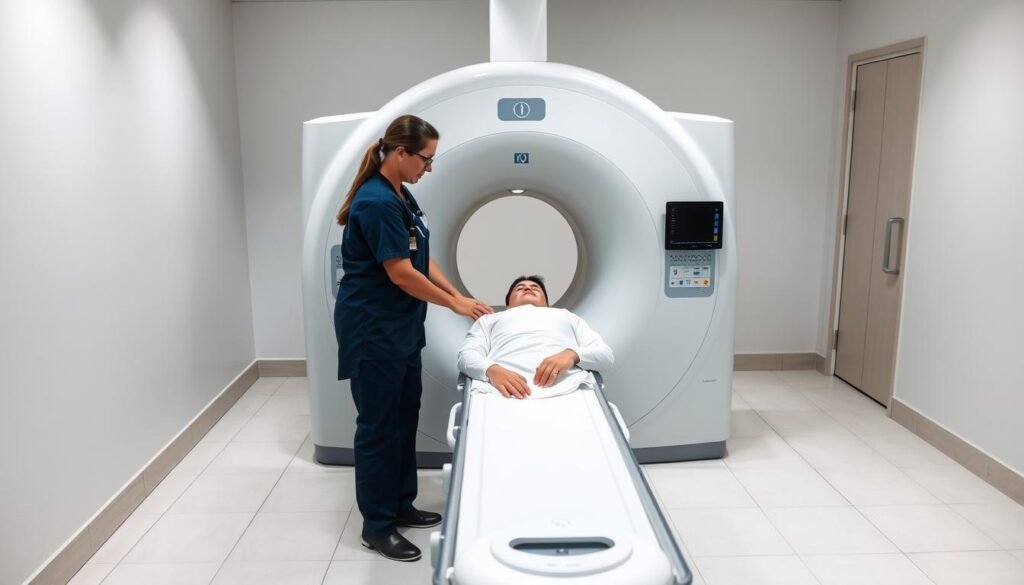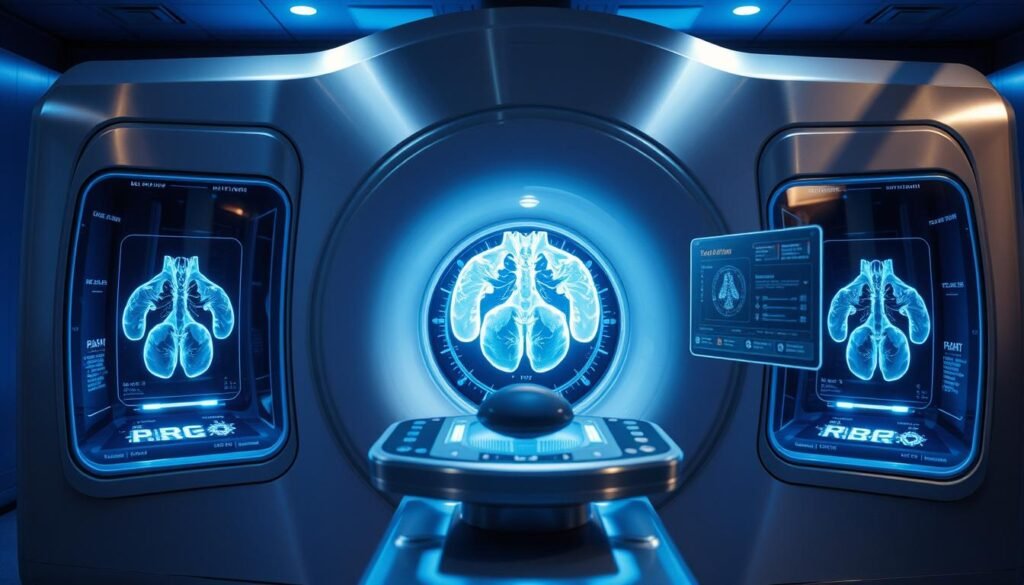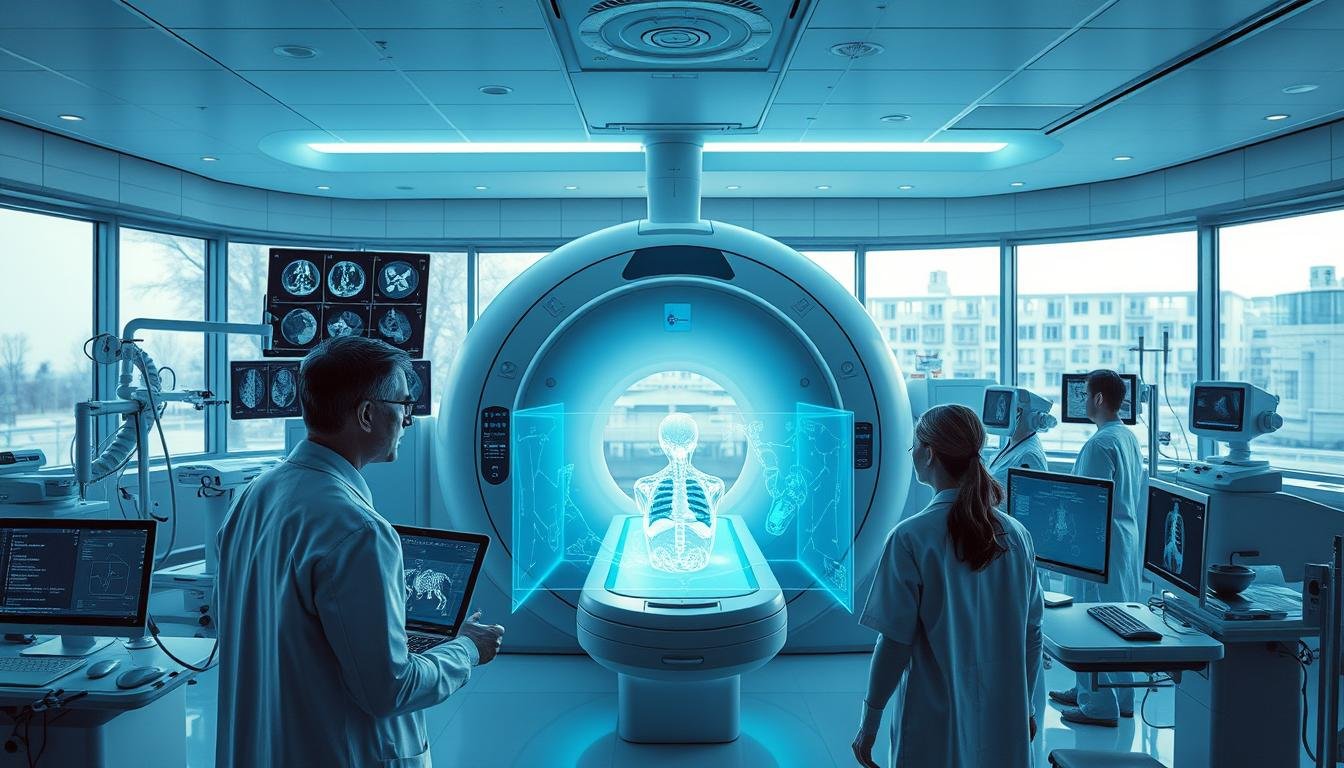MRI and Imaging: A Comprehensive Guide for Patients
Understanding medical imaging is crucial for patients undergoing diagnostic procedures. Diagnostic imaging plays a vital role in healthcare, enabling doctors to diagnose and treat various conditions effectively.
This comprehensive guide is designed to inform patients about the basics of mri and imaging procedures, ensuring they are well-prepared for their diagnostic journey.
Key Takeaways
- Understanding the role of medical imaging in healthcare.
- Preparation tips for diagnostic imaging procedures.
- What to expect during an MRI or imaging test.
- The importance of diagnostic imaging in patient care.
- Common applications of medical imaging technologies.
The Basics of MRI and Imaging
MRI and imaging technologies have revolutionized the field of medicine, offering unparalleled insights into the human body. These diagnostic tools have become indispensable in modern healthcare, enabling doctors to visualize the internal structures of the body in great detail.
What Is Medical Imaging?
Medical imaging refers to the techniques used to create images of the internal structures of the body. These images help healthcare professionals diagnose and treat medical conditions. Various imaging modalities are available, including X-rays, CT scans, ultrasound, and MRI, each providing unique information about the body’s internal structures.
The Science Behind MRI Technology
Magnetic Resonance Imaging (MRI) is a non-invasive imaging technique that uses strong magnetic fields and radio waves to generate detailed images of the body’s internal structures. MRI technology is particularly useful for imaging soft tissues, such as organs and tendons, which are not as visible with other imaging modalities.
How Diagnostic Imaging Aids Medical Decisions
Diagnostic imaging plays a crucial role in aiding medical decisions by providing healthcare professionals with accurate and detailed images of the body’s internal structures. This information is vital for diagnosing conditions, planning treatments, and monitoring the effectiveness of interventions.
| Imaging Modality | Primary Use | Benefits |
|---|---|---|
| MRI | Soft tissue imaging | High-resolution images of organs and tendons |
| CT Scans | Internal injury assessment | Quick and detailed imaging of internal injuries |
| X-rays | Bone and lung imaging | Fast and effective for diagnosing bone fractures and lung conditions |
Types of Medical Imaging Procedures
Medical imaging procedures are pivotal in modern healthcare, offering a window into the body’s internal structures without the need for surgery. These diagnostic tools enable healthcare professionals to visualize the internal workings of the body, helping to identify and manage a wide range of medical conditions.
Magnetic Resonance Imaging (MRI) Explained
MRI is a non-invasive imaging technique that uses powerful magnetic fields and radio waves to produce detailed images of the body’s internal structures. It’s particularly useful for examining soft tissues, such as organs and tendons. MRI scans are commonly used to diagnose conditions affecting the brain, spine, and joints.
Computed Tomography (CT) Scans
CT scans utilize computer-processed combinations of multiple X-ray measurements taken from different angles to produce cross-sectional images of the body. This allows for the detailed examination of internal structures, including bones, blood vessels, and soft tissues. CT scans are often used in emergency situations to quickly assess injuries or detect conditions such as internal bleeding.
X-rays and Radiography
X-rays are a form of electromagnetic radiation used to create images of the body’s internal structures, particularly bones. Radiography, the process of using X-rays to create these images, is one of the oldest and most commonly used imaging techniques. It’s frequently used to diagnose bone fractures, lung conditions, and foreign objects within the body.
Ultrasound Imaging
Ultrasound imaging, also known as sonography, uses high-frequency sound waves to create images of the inside of the body. It’s a safe, non-invasive procedure that’s particularly useful for examining organs such as the gallbladder, liver, and kidneys, as well as for monitoring fetal development during pregnancy.
Nuclear Medicine Imaging
Nuclear medicine imaging involves the use of small amounts of radioactive materials to diagnose and determine the severity of or treat a variety of disease, including many types of cancers, heart disease, gastrointestinal, endocrine, or neurological disorders.
As highlighted by a medical expert, “Nuclear medicine imaging provides functional information that can be critical in diagnosing and managing complex medical conditions.”
“The choice of imaging procedure depends on the specific medical condition being diagnosed or monitored, as well as the patient’s overall health.”
When Your Doctor Orders an MRI or Imaging Test
An MRI or imaging test is often a crucial diagnostic tool that your doctor may recommend to gain a clearer understanding of your condition. This decision is typically made after a thorough evaluation of your symptoms and medical history.
Common Medical Conditions Requiring Imaging
Several medical conditions may necessitate diagnostic imaging. These include:
- Musculoskeletal injuries or disorders
- Neurological conditions such as stroke or multiple sclerosis
- Cancer diagnosis and monitoring
- Cardiovascular diseases
Understanding Your Doctor’s Referral
It’s essential to understand why your doctor has recommended an MRI or imaging test. This procedure can help your doctor:
- Confirm a diagnosis
- Rule out certain conditions
- Plan appropriate treatment
Questions to Ask Before Your Procedure
Before undergoing an MRI or imaging test, consider asking your doctor:
- What will the test help determine?
- Are there any risks or side effects?
- How should I prepare for the test?
Getting a Second Opinion on Imaging Recommendations
If you’re unsure about the necessity of the recommended medical imaging test, seeking a second opinion is a viable option. This can provide additional insight and reassurance.
Preparing for Your MRI and Imaging Appointment
As you prepare for your MRI or imaging appointment, understanding the steps you can take beforehand can significantly ease your experience. Being well-prepared not only helps in reducing anxiety but also ensures that the procedure is conducted efficiently.
Pre-Appointment Checklist
Before your appointment, it’s essential to complete a few tasks. First, confirm the appointment details, including the date, time, and location of the imaging center. You should also receive instructions on any specific preparations you need to make. Make sure to ask about any concerns you have regarding the procedure or the radiology services provided.
Dietary and Medication Guidelines
Depending on the type of MRI scan or imaging test you’re undergoing, you may be required to follow specific dietary guidelines or adjust your medication. For instance, some procedures may require fasting or avoiding certain foods and drinks. Always follow the instructions provided by your healthcare provider or the imaging center.

What to Wear and What to Leave at Home
On the day of your appointment, wear loose, comfortable clothing that doesn’t contain metal. You’ll likely be asked to change into a gown, so avoid wearing anything complicated. Also, leave jewelry, glasses, and any metal objects at home to avoid any complications during the MRI scan.
Special Preparations for Contrast Imaging
If your procedure involves contrast imaging, you’ll receive specific instructions on how to prepare. This may include information on any necessary fasting or the timing of your last meal. The technologist will also explain the process of administering the contrast agent.
Arranging Transportation and Support
For some imaging procedures, particularly those involving sedation, you may need to arrange for someone to drive you home. Even if you’re not sedated, having a friend or family member with you can provide emotional support.
By following these guidelines, you can ensure a smooth and successful imaging experience. If you have any questions or concerns, don’t hesitate to reach out to your healthcare provider or the imaging center for guidance.
What to Expect During Your MRI and Imaging Procedure
Undergoing an MRI or imaging procedure can be a daunting experience, but understanding what to expect can significantly ease your anxiety. As you prepare for your appointment, it’s helpful to know the steps involved in the process, from the initial preparation to the completion of the scan.
Step-by-Step Walkthrough of a Typical Procedure
When you arrive at the imaging center, you will typically be asked to change into a comfortable gown and remove any metal objects or jewelry. A technologist will then explain the procedure and position you on the imaging table. For an MRI, you will be slid into the MRI machine, which is a large, cylindrical tube. The technologist will communicate with you through an intercom system throughout the scan.
Duration and Positioning Requirements
The length of the procedure can vary depending on the type of scan and the body part being imaged. Generally, an MRI can take anywhere from 15 to 90 minutes. You will be required to remain still during the scan to ensure clear images. The technologist will help you get into the correct position and provide support if needed.
Managing Claustrophobia and Anxiety
If you experience claustrophobia or anxiety, it’s essential to inform your doctor or the imaging center beforehand. They may offer sedation or recommend an open MRI machine, which can be less confining. Deep breathing exercises and communication with the technologist can also help you relax during the procedure.
Communication with Technologists During the Scan
Throughout the scan, you will be able to communicate with the technologist through the intercom system. If you experience any discomfort or need to stop the scan, you can let them know. The technologist will also provide you with instructions and updates during the procedure.
Common Sounds and Sensations You May Experience
During an MRI, you may hear loud knocking or thumping sounds as the machine operates. You will be provided with earplugs or headphones to help reduce the noise. Some people may experience a sensation of warmth or coolness during the scan, especially if contrast dye is used.
| Procedure Aspect | Description | Tips for Comfort |
|---|---|---|
| Preparation | Changing into a gown, removing metal objects | Arrive early, wear comfortable clothing |
| Positioning | Getting into the correct position on the imaging table | Communicate with the technologist about any discomfort |
| Scan Duration | Can range from 15 to 90 minutes | Relax, remain still for clear images |
| Noise and Sensations | Loud knocking sounds, possible warmth or coolness | Use earplugs or headphones, inform technologist of discomfort |
Advanced MRI and Imaging Techniques
As medical technology advances, so does the sophistication of MRI and imaging techniques, offering unprecedented insights into the human body. These advancements are crucial for improving diagnostic accuracy and treatment planning.
Functional MRI (fMRI) and Its Applications
Functional MRI (fMRI) is a specialized imaging technique that measures brain activity by detecting changes associated with blood flow. This technique is invaluable in neuroscience research and clinical diagnostics, helping to map brain functions and identify areas affected by neurological disorders.
3D Imaging Technology
3D imaging technology has revolutionized the field of medical imaging by providing detailed three-dimensional representations of the body’s internal structures. This technology enhances the ability to diagnose complex conditions and plan surgical interventions.

Open MRI vs. Traditional MRI
The choice between open MRI and traditional MRI depends on the patient’s needs and the specific requirements of the imaging procedure. Open MRI machines offer a more spacious environment, which is beneficial for patients with claustrophobia or larger body types.
Specialized Imaging for Specific Body Parts
Specialized imaging techniques are designed to provide detailed images of specific body parts, such as the heart, breast, or prostate. These techniques are critical for diagnosing and managing conditions affecting these areas, offering targeted diagnostic information that guides treatment decisions.
Advanced MRI and imaging techniques are continually evolving, offering new possibilities for medical diagnosis and treatment. By understanding these techniques, patients can better appreciate the diagnostic processes and the information derived from their imaging procedures.
Choosing the Right Imaging Center and Radiology Services
Understanding what to look for in an imaging center can help ensure you receive the best care possible. When faced with the need for medical imaging, patients are often confronted with numerous options for imaging services. However, not all centers are created equal.
Evaluating Imaging Center Credentials and Equipment
It’s essential to choose an imaging center that is accredited by a recognized accrediting organization, such as the American College of Radiology (ACR). Accreditation ensures that the facility meets specific standards for quality and safety. Additionally, inquire about the type of equipment used. Modern equipment, like high-field MRI machines, can provide more accurate and detailed images.
Questions to Ask When Selecting a Facility
When selecting an imaging center, there are several questions you should ask. These include: What experience do the technologists and radiologists have? Is the facility equipped to handle your specific needs? What is the wait time for an appointment and for receiving results? Are the facilities clean and comfortable?
The Importance of Experienced Radiologists
Experienced radiologists play a critical role in the accuracy of your diagnosis. They are trained to interpret complex images and identify subtle abnormalities. A center with experienced radiologists can provide more reliable results and, if necessary, additional guidance on next steps.
Accessibility and Comfort Considerations
Consider the location and accessibility of the imaging center. A conveniently located center can make it easier to keep your appointment. Additionally, consider the comfort measures in place, such as sedation options for claustrophobic patients or amenities to reduce anxiety.
| Factor | What to Look For | Why It Matters |
|---|---|---|
| Accreditation | Accreditation from recognized bodies like ACR | Ensures quality and safety standards are met |
| Equipment | Modern, high-field MRI machines and latest technology | Provides more accurate and detailed images |
| Staff Experience | Experienced technologists and radiologists | Impacts the accuracy and reliability of results |
After Your Imaging Procedure: Next Steps and Results
Once your diagnostic imaging is complete, knowing what to expect can make a significant difference in your overall experience. The period following your MRI scan or imaging procedure is a time of anticipation, and being informed can help alleviate concerns.
Immediate Post-Procedure Care
After your procedure, you might be required to stay at the imaging center for a short period to ensure there are no adverse reactions, especially if a contrast agent was used. It’s essential to follow the specific instructions provided by the radiology services team.
Understanding Result Timeframes
The timeframe for receiving your imaging results can vary depending on the complexity of the procedure and the facility’s protocols. Typically, results are available within a few hours to a few days. Your healthcare provider will guide you on when to expect your results.
How to Interpret Your Imaging Reports
Imaging reports are detailed documents that require professional interpretation. Your radiologist will analyze the images and provide a report to your doctor, who will then discuss the findings with you. It’s crucial not to attempt to interpret the results yourself.
Follow-up Appointments and Consultations
After receiving your imaging results, your doctor will likely schedule a follow-up appointment to discuss the findings and any necessary next steps. This is an opportunity to ask questions and understand your diagnosis and treatment options.
Getting Copies of Your Images and Reports
You have the right to obtain copies of your imaging records, including images and reports. Ask your healthcare provider about the process for obtaining these records, as they may be required for future medical consultations or second opinions.
| Next Steps | Description | Timeline |
|---|---|---|
| Post-Procedure Care | Follow instructions from radiology services | Immediately after procedure |
| Result Timeframe | Varied based on procedure complexity | Few hours to few days |
| Follow-up Appointment | Discuss findings and next steps with doctor | Scheduled by doctor |
“Understanding your diagnostic imaging results is a crucial step in your healthcare journey. Ensure you follow up with your healthcare provider to discuss your findings and any subsequent actions.”
Conclusion
Understanding the intricacies of MRI and imaging procedures can significantly impact a patient’s experience. By grasping the basics of medical imaging, individuals can better navigate their diagnostic journey.
From the various types of medical imaging procedures to preparing for an appointment and understanding the results, being informed is key. MRI and imaging technologies, such as MRI, CT scans, and ultrasound, play a crucial role in medical diagnosis, enabling healthcare professionals to make accurate decisions.
By being aware of what to expect during an MRI or imaging procedure, patients can reduce anxiety and feel more in control. Choosing the right imaging center and understanding the role of radiologists are also vital components of a successful diagnostic experience.
In conclusion, medical imaging is a powerful tool in healthcare, and being knowledgeable about MRI and imaging procedures can make a significant difference for patients. By staying informed, individuals can ensure a smoother, more confident experience throughout their diagnostic journey.







